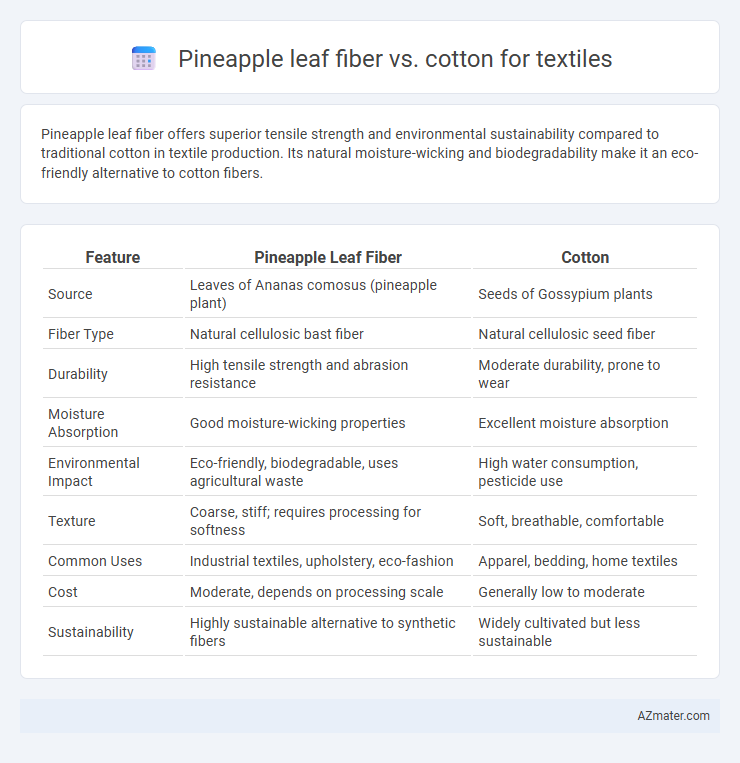Pineapple leaf fiber offers superior tensile strength and environmental sustainability compared to traditional cotton in textile production. Its natural moisture-wicking and biodegradability make it an eco-friendly alternative to cotton fibers.
Table of Comparison
| Feature | Pineapple Leaf Fiber | Cotton |
|---|---|---|
| Source | Leaves of Ananas comosus (pineapple plant) | Seeds of Gossypium plants |
| Fiber Type | Natural cellulosic bast fiber | Natural cellulosic seed fiber |
| Durability | High tensile strength and abrasion resistance | Moderate durability, prone to wear |
| Moisture Absorption | Good moisture-wicking properties | Excellent moisture absorption |
| Environmental Impact | Eco-friendly, biodegradable, uses agricultural waste | High water consumption, pesticide use |
| Texture | Coarse, stiff; requires processing for softness | Soft, breathable, comfortable |
| Common Uses | Industrial textiles, upholstery, eco-fashion | Apparel, bedding, home textiles |
| Cost | Moderate, depends on processing scale | Generally low to moderate |
| Sustainability | Highly sustainable alternative to synthetic fibers | Widely cultivated but less sustainable |
Introduction to Pineapple Leaf Fiber and Cotton
Pineapple leaf fiber, derived from the leaves of the Ananas comosus plant, is a sustainable and eco-friendly textile material known for its high tensile strength and natural luster. Cotton, one of the most widely used natural fibers, is valued for its softness, breathability, and versatility in fabric production. Both fibers offer distinct qualities: pineapple leaf fiber excels in durability and sustainability, while cotton is preferred for comfort and easy dyeing.
Origins and Production Processes
Pineapple leaf fiber originates from the long, tough leaves of the Ananas comosus plant, primarily grown in tropical regions like the Philippines, while cotton is derived from the soft, fluffy fibers surrounding the seeds of the Gossypium plant cultivated worldwide. Pineapple leaves undergo a decortication process to extract the fibers, involving mechanical scraping and washing, followed by drying and sometimes chemical treatments to enhance softness and durability. Cotton production involves harvesting the seed cotton, ginning to separate fibers from seeds, and then carding and spinning the fibers into yarn, a process that has been industrialized extensively for mass textile manufacturing.
Environmental Impact and Sustainability
Pineapple leaf fiber offers a sustainable alternative to cotton, utilizing agricultural waste that would otherwise be discarded, significantly reducing landfill burden and promoting circular economy practices. It requires minimal water and pesticides compared to cotton, whose cultivation is notably water-intensive and contributes to soil degradation and pesticide pollution. Pineapple fiber's biodegradability and lower carbon footprint support eco-friendly textile production, aligning with increasing demand for sustainable materials in the fashion industry.
Fiber Properties and Strength
Pineapple leaf fiber exhibits higher tensile strength and greater stiffness compared to cotton, making it ideal for durable textile applications. The fiber's natural lignin content contributes to its robustness and resistance to wear, while cotton fibers provide superior softness and breathability due to their cellulose-rich structure. Pineapple leaf fiber's coarse texture contrasts with cotton's fine, flexible strands, influencing the choice between them based on end-use requirements for strength versus comfort.
Comfort and Wearability
Pineapple leaf fiber offers excellent breathability and moisture-wicking properties, making it a comfortable option for hot and humid climates compared to cotton. While cotton is softer and more pliable, pineapple leaf fiber's natural texture provides durability and resistance to wear, enhancing garment longevity. Both fibers support comfort, but pineapple leaf fiber excels in moisture management and eco-friendly appeal for sustainable textile applications.
Applications in the Textile Industry
Pineapple leaf fiber offers exceptional strength and durability compared to cotton, making it ideal for high-performance textiles such as upholstery, geotextiles, and eco-friendly fashion. Its natural moisture-wicking and antibacterial properties enhance comfort and hygiene in activewear and home textiles, positioning it as a sustainable alternative to traditional cotton fabrics. The growing demand for biodegradable fibers in the textile industry accelerates the adoption of pineapple leaf fiber in composite materials and blended fabrics.
Durability and Maintenance
Pineapple leaf fiber offers superior durability compared to cotton, as its long, strong fibers resist wear and tear, making it ideal for heavy-use textiles. Maintenance for pineapple leaf fiber is relatively low since it is naturally resistant to moisture and pests, reducing the need for frequent washing or chemical treatments. Cotton, while softer and more breathable, requires more intensive care to prevent shrinking, fading, and damage from mildew.
Cost Effectiveness and Market Availability
Pineapple leaf fiber (PALF) offers a cost-effective alternative to cotton due to its lower production costs, as pineapple leaves are agricultural waste byproducts easily sourced from existing pineapple farms. Despite initial limited processing infrastructure, PALF's market availability is expanding rapidly in regions with pineapple cultivation, making it a competitive sustainable textile fiber. Cotton remains widely available with established global supply chains but involves higher water and pesticide-related costs, impacting overall cost efficiency compared to PALF.
Innovations and Future Trends
Pineapple leaf fiber (PALF) is emerging as a sustainable alternative to cotton in textiles due to its natural strength, biodegradability, and lower water usage. Innovations such as enzyme treatments and nanotechnology enhance PALF's softness and durability, making it competitive with conventional cotton fabrics. Future trends indicate increasing integration of PALF with smart textiles and eco-friendly dyeing techniques, promoting circular fashion and reducing the environmental footprint of textile production.
Conclusion: Choosing Between Pineapple Leaf Fiber and Cotton
Pineapple leaf fiber offers superior sustainability with its biodegradable properties and low water usage compared to cotton, which demands extensive irrigation and pesticides. While cotton provides a softer texture and widespread availability, pineapple leaf fiber excels in durability and eco-friendliness, making it ideal for eco-conscious textile production. Selecting between these fibers depends on prioritizing environmental impact or traditional fabric feel in textile manufacturing.

Infographic: Pineapple leaf fiber vs Cotton for Textile
 azmater.com
azmater.com